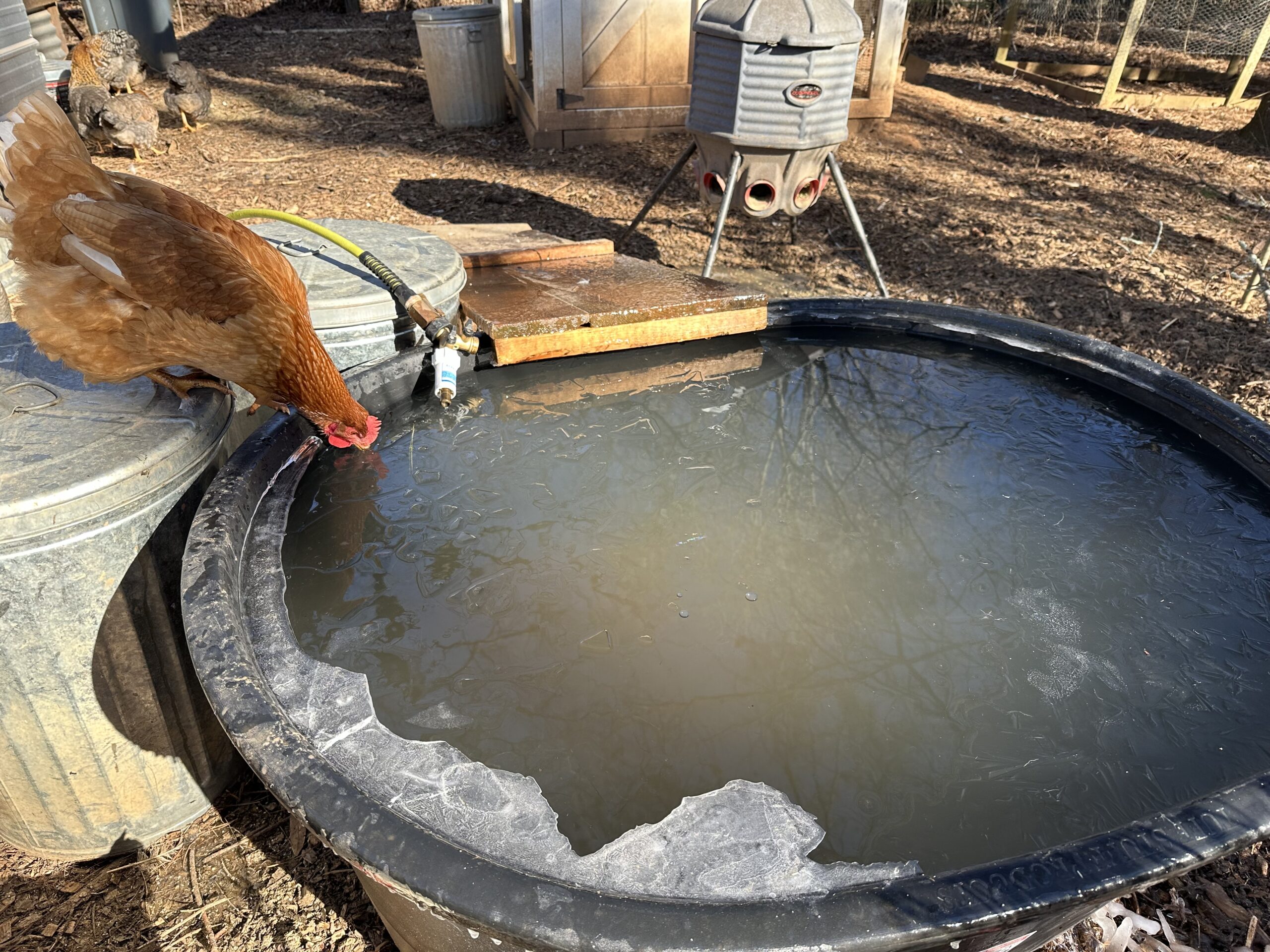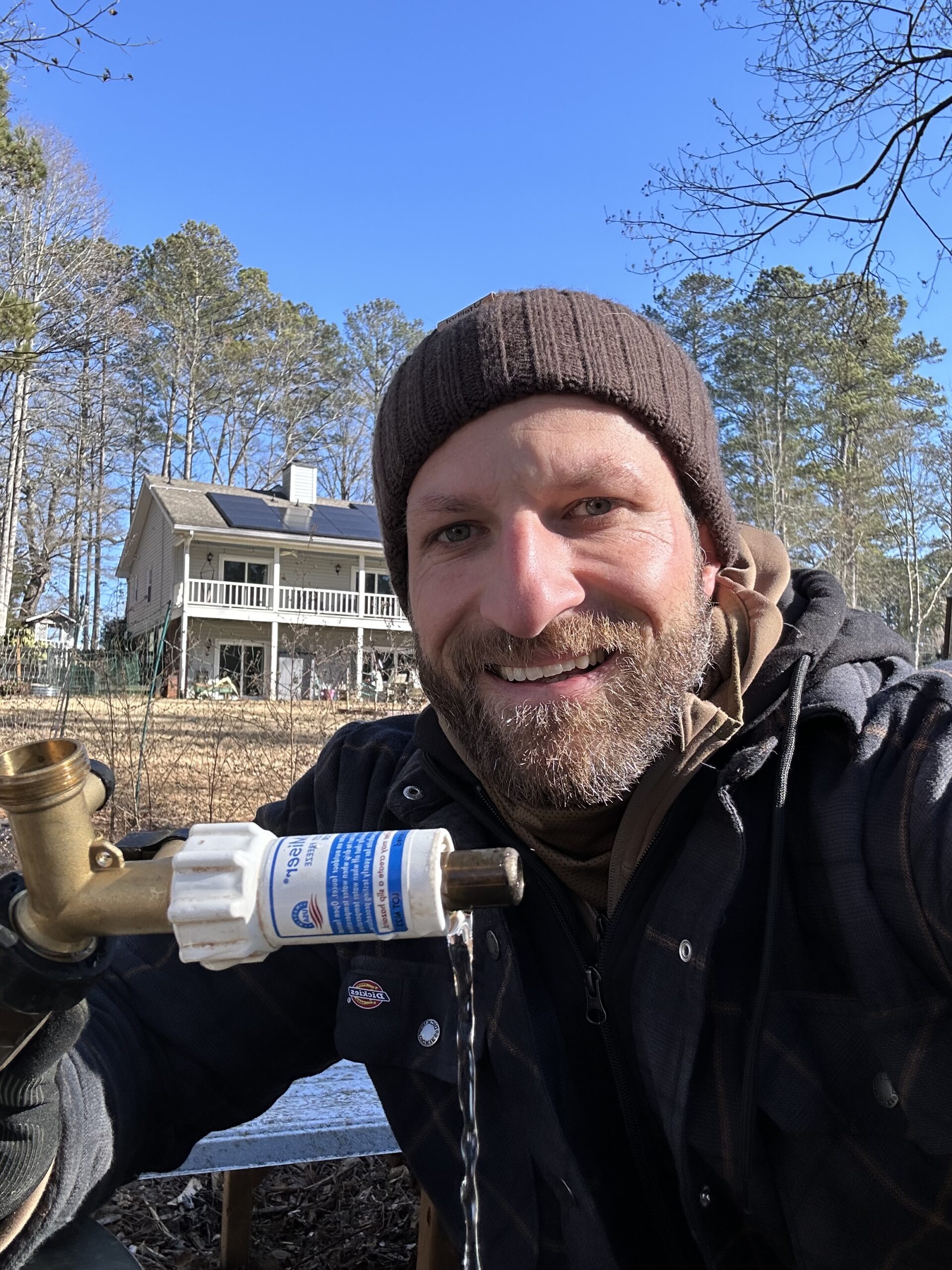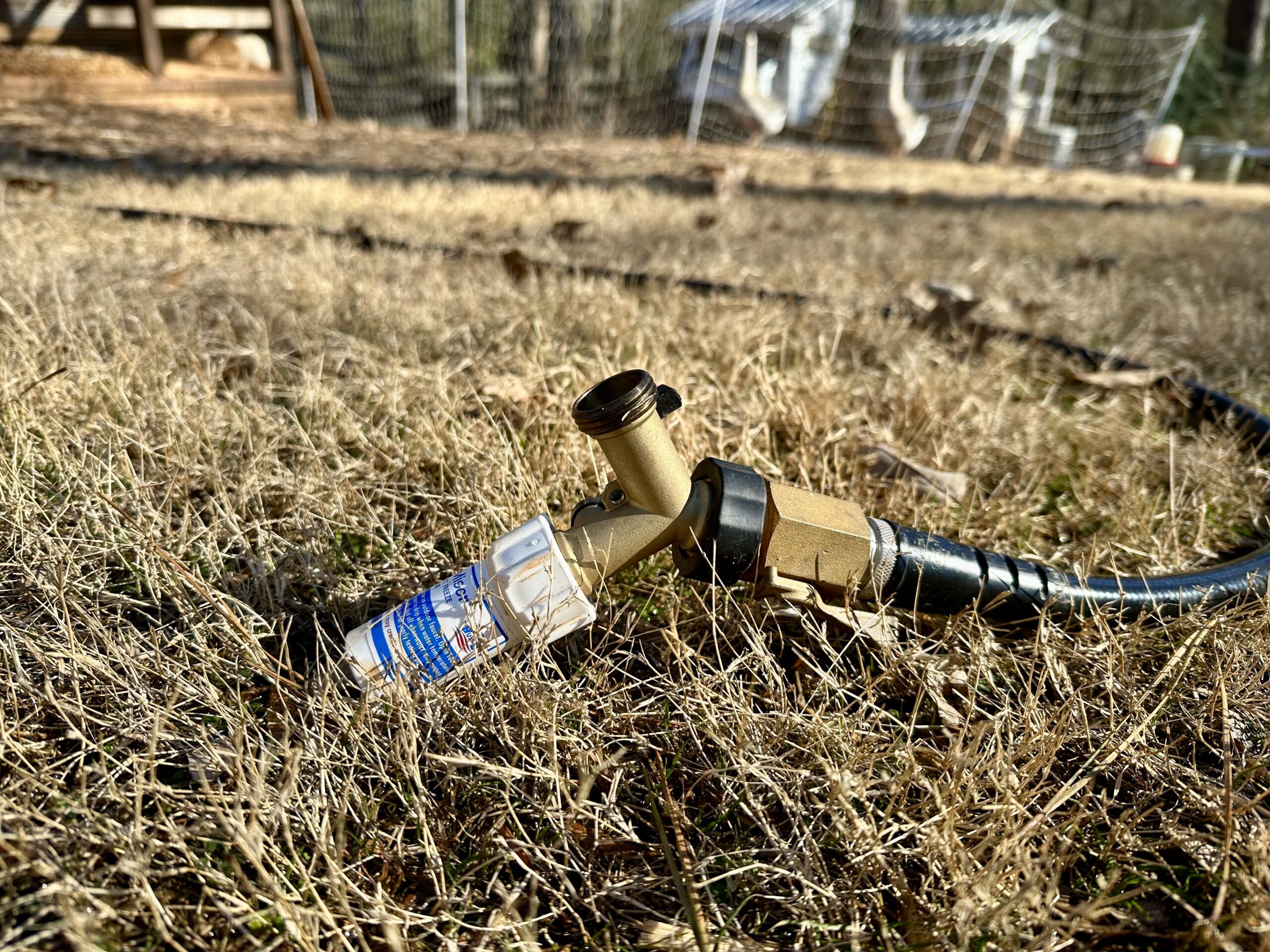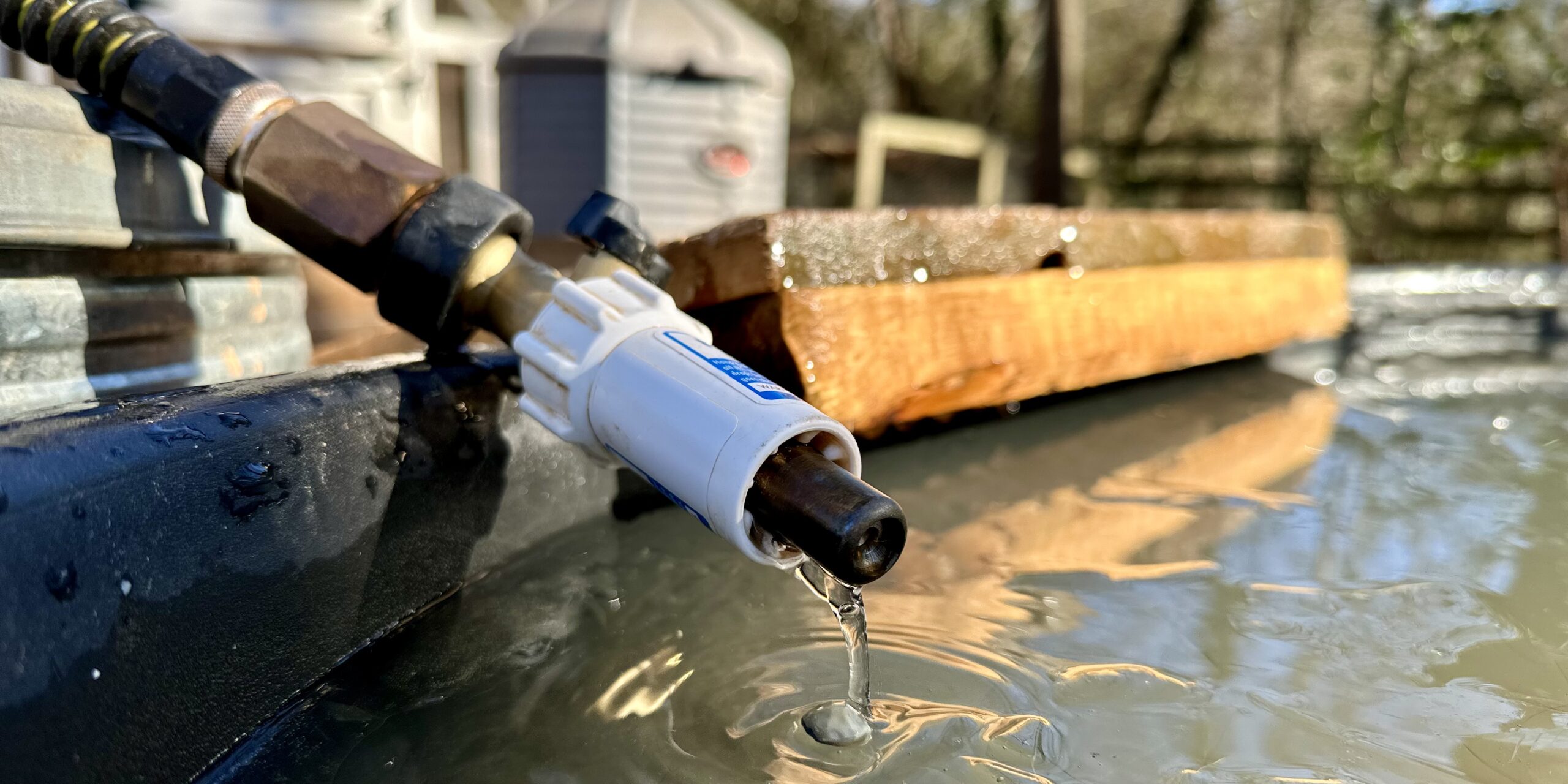The Freeze Miser is a device you can screw onto an outdoor faucet or the end of a garden hose to prevent the water inside the pipes (or the hose) from freezing when temperatures drop below 33° F (0° C). The device leverages thermal wax that shrinks or expands based on the water’s temperature, thus maintaining a constant water flow (like a trickle) before the water turns solid.
In other words, it mimics the well-known DIY approach of keeping the tap open a bit to allow water to trickle out. However, Freeze Miser automatically adjusts the water’s flow rate to the water temperature. As a result, you don’t waste more water than necessary to prevent it from freezing.

If you raise livestock in an area that gets freezing weather during winter, you know that preventing the water in pipes, hoses and troughs from freezing can be a major issue that makes daily chores much more time-consuming than they need to be.
Our homestead is located in northern Georgia, and we usually enjoy relatively mild winters where extended freezing conditions are rare. But almost every year, at the beginning of January, we get at least a few days in the high teens that cause all our automated watering systems to freeze.
In the past, that meant using a hammer in the morning to break the ice in the water troughs, and hauling fresh water from the house using buckets. A couple of hours later, we’d rinse and repeat, which was a major time drain.
Fortunately, I stumbled across Freeze Miser (thanks to an ad I saw on Instagram), which promised to prevent the water in our non-toxic garden hoses (that run all the way from the house to the animal shelters) from freezing, thus significantly improving our water situation and speeding up morning chores.
It’s been several weeks now since we added multiple Freeze Misers to our watering infrastructure, and they’ve been doing an outstanding job. Given that, I figured I’d spread the word so others can benefit from this ingenious device.
In this Freeze Miser review, I share the following:
- How Freeze Miser works to prevent water from freezing.
- How to install and use Freeze Miser.
- How we use the Freeze Miser at the Kummer Homestead (best practices).
- Some of the Freeze Miser limitations we ran into.
- Pricing and whether Freeze Miser is worth it.
I should also mention that some people have successfully used the Freeze Miser in combination with water wells and water heaters, but since those aren’t relevant use cases for us, I won’t cover them in detail.
Freeze Miser Review
Overall, I have little to complain about with the Freeze Miser. It works as advertised and had no issues preventing the water in our 100-foot garden hoses from freezing when the temperature dropped to 12° F.
| Pros | Cons |
|---|---|
| It’s a mechanical device with few moving parts that could break. | It won’t work in exceptionally cold climates. |
| Easy to install and use. | It wastes (some) water. |
| Comes with a two-year warranty. | The cost can add up if you need numerous devices. |
| It works incredibly well. |
How Freeze Miser Works

What I love about the Freeze Miser is its simplicity. It’s a mechanical device consisting of brass, stainless steel and polypropylene (plastic) components, thermal wax and a couple of O-rings. In a way, Freeze Miser acts like a thermostat that constantly “monitors” the incoming water temperature (as opposed to the air temperature). As the water temperature drops, the wax inside the device shrinks, allowing water to flow through it.
No water starts flowing until the temperature inside your hose (or faucet) drops to 37° F (3° C). The colder the water gets, the more the wax shrinks and the more water flows. If the water temperature increases, the wax expands, slowing down (or restricting) the water flow.
As a result, you could leave the Freeze Miser installed on your hoses or faucets all year because it won’t leak any water until it gets cold enough. However, we take the Freeze Misers off our hoses and faucets in the spring, and clean and store them to avoid them being exposed to the elements. That will hopefully extend their lifespan.
How to Install and Use the Freeze Miser

Installing the Freeze Miser is relatively straightforward. All you have to do is screw it on the end of your garden hose or outdoor faucet and turn on the water. You don’t need any tools; just hand-tighten it to avoid damaging the O-rings.
One of the things I noticed in the beginning was water gushing out of the Freeze Miser at a much higher rate than I had expected. At first, I thought the device might be defective, until I read the instructions and learned that this is perfectly normal.
In other words, the Freeze Miser self-calibrates the water flow, and that might result in an increased outflow that won’t last longer than 90 seconds. After that calibration period, the water flow slowed down to a trickle. So don’t worry about wasting a ton of water.
How We Use the Freeze Miser at the Kummer Homestead
We run several garden hoses (some of them daisy-chained using Y adapters) from an outdoor faucet at our house down to the rabbit hutches and chicken coops.
At the end of each run, we installed a two-way Y-valve shut-off. By leveraging the Y-valve, we’re able to install the Freeze Miser on one side while still being able to operate the hose (i.e., turn on the water) on the other side.
When I first purchased the first Freeze Miser, I didn’t use a Y-valve, and so I had to remove the device every time I wanted to use the hose (e.g., to refill a water through). That was inconvenient, and it increased the risk of forgetting to turn the water back on after reinstalling the device. Using the Y-valve, the faucet the hose is connected to can remain turned on because I can shut off the water at the Y-valve level.
Some of the Limitations We Ran Into
I don’t have much negative to say about the Freeze Miser because it works exactly as advertised. However, it’s worth noting that if you live in a climate that experiences temperatures below the freezing point for extended periods, even slow trickling water can add up and become noticeable on your water bill (unless you’re on a well).
The best way to avoid wasting water is to position the Freeze Miser so that the water can trickle into a container or rain barrel. That way, you can save the water and use it for your animals, or to water plants.
We used to have a 20-gallon tub for our two African Geese to bathe in, and every other day, I’d dump it and refill it with fresh water. When we got the Freeze Miser, I’d dump the water in and let the trickle fill up the tub overnight.
When the geese outgrew that small tub, we switched to a 100-gallon tub. Since we don’t change that water every other day, I just let the Freeze Miser top off the tub every night, since the geese spill some of the water during the day. During most nights, the water overflows, but at least the movement prevents the water from freezing solid.
If you’re on city water and sewer, I’d definitely recommend catching the water and saving it for later to reduce your water and sewer bill. (Where we live, every gallon of water we consume gets tacked onto the sewer bill, and that can get expensive.)
If you have a natural body of water, such as a pond, you can let the water flow into that as well.
It’s also worth noting that the Freeze Miser will likely not work in locations where flowing water freezes. In other words, if the river in your town regularly freezes over in winter, the Freeze Miser will likely not prevent your outdoor faucets or garden hoses from freezing.
Based on reports from the company, the coldest recorded air temperature the Freeze Miser can handle is -35° F (without taking wind chill into account) on a 150-foot hose. That should give you a reference point of whether the Freeze Miser will work for you.
Is Freeze Miser Worth Its Cost?

The Freeze Miser is available in several configurations that vary in price and range from $29.95 (for an individual unit) to $39.95 (for a combo that includes the recommended Y-valve). You can also purchase sets of four, eight and 16 for a small discount.
Depending on how many hoses and outlets you have, paying $30 per device can add up. Still, the less time I have to spend worrying about our animals’ water situation, the more time and mental bandwidth I have to do things that have the potential to generate income (like writing a new blog post or recording new YouTube videos). So for me, the Freeze Miser is worth it!
In case you’re wondering, the Freeze Miser is also available on Amazon, albeit at a higher price and sold by third-party sellers. I prefer purchasing directly from the manufacturer and usually avoid purchasing from third parties on Amazon because I like directly supporting small businesses and don’t want to risk getting a counterfeit product.
Frequently Asked Questions
Absolutely! I recommend using a Y-adapter, connecting one end to the float valve and the other one to the Freeze Miser. The added bonus of using such a setup is that the water trickling out of the Freeze Miser will go into your stock tank.
Yes, you can use the Freeze Miser for outdoor faucet freeze protection. I’d recommend ensuring the area below the faucet is graded so that water can run off properly and not cause any potential water damage.
The Freeze Miser activates when the internal water temperature drops below 37° F. The colder the water temperature gets, the more water Freeze Miser will allow through.
While you can likely get a quality faucet cover for less money than you’d pay for the Freeze Miser, the problem is that the former doesn’t cover the piping behind the siding or wall, which might also get exposed to freezing temperatures. If that’s the case, the water in your exterior pipes might still freeze, potentially causing them to burst.
Additionally, you have to take a faucet cover off (if you want to use the faucet) and then remember to put it back on. With Freeze Miser, you don’t have to worry about anything. With all those factors combined, I’d argue that the Freeze Miser is the better solution.
Freeze Miser Review: Final Verdict
There are countless methods that can help prevent water from freezing during the colder months of the year. We leverage several of them, including heating wires for our nipple-based rabbit and chicken waterers. You can also drop ping pong balls or straw into water troughs to change the surface tension and encourage movement.
However, there are only so many ways to prevent water from freezing in pipes and garden hoses, and the Freeze Miser appears to be the most effective way to do it.
I love “set it and forget it” approaches that don’t require me to think about the problem. Freeze Miser doesn’t require any maintenance or daily interaction; you install it, turn on the water and walk away. That’s all it takes to prevent frozen hoses.
Now I’d like to hear from you! Do you live in an area that experiences freezing temperatures in winter? If so, how do you handle your animals’ water situation? Let me know by leaving a comment below!

Michael Kummer is a healthy living enthusiast, the founder of MK Supplements and the host of the Primal Shift podcast. His goal is to help people achieve optimal health by bridging the gap between ancestral living and the demands of modern society. He runs the Kummer Homestead with his wife Kathy and their two children.

Just recently purchased 2 of the Freeze Mizers. First night only put on faucet not end of hose so hose froze but not faucet 2nd night I left on faucet and put second one on hose. Temp fell to 19F with wind chill to 9F. The hose mizer in morning was running nearly full with an ice pond all around it. Wasn’t expecting so much water coming from it. Had to shut hose off and froze up. Could that mixer have bee defective is my question? Faucet one was ok with very little water on ground.
Hey Steve,
The Freeze Miser adjust water flow based on the water temperature. Considering that there is more hose (and water) exposed to the cold temps, I suspect it had to keep the water flow that high to prevent it from freezing. How long was your hose?
Cheers,
Michael
I have purchased six freezemisers in the last two years, they work great for one season but do not work the second year water discharges continually regardless of temperature.
Hey Stephen,
Have you reached out to the manufacturer about this issue? We’ve been using our FreezeMisers for the second year and they’ve been working flawlessly.
I have two outdoor spigots. I n installed Freeze Misers on both of them. One works fine. A small stream of water will be emitted when the temp goes below 37. On the other spigot I have tried two other Freeze Misers which pour water out of the spigot. Why is this happening?
I experienced the same issue the other day but it resolved itself after I removed the Freezer Miser, waited a moment and then screwed it back in. I reached out to the company for guidance but haven’t heard back yet.
I installed 3 on three separate spickets and not one sealed. so I called tech support and they suggested that I chang my three spickets I’m not going to do that.
Hey John!
What do you mean by “not sealed?” I sealed the threading of my spickets (where necessary) with some teflon tape and an O-ring.
Cheers,
Michael
We are based in Lesotho (South Africa)
I would like to try and see if it works in our environment. Would like to purchase from
original entity?
Hey Anton,
you’d have to reach out to Freezer Miser directly (https://www.freezemiser.com/).
Cheers,
Michael